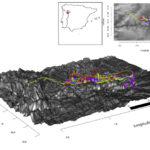Bats use topography and nocturnal updrafts to fly high and fast
By KaciGu On February 18, 2021 · Leave a Comment · In 2021 SP Team 06, 2021 SP Week 03, Biological Discoveries
O’Mara et al. use high-resolution GPS tracking and atmospheric models to show that, similar to diurnal birds, European free-tailed bats use uplifting winds generated by the nocturnal energy landscape to rapidly ascend over 1,600 m above ground level and achieve maximum self-powered airspeeds over 130 km/hour.
Learn about our two Decals!
 Click here to find out more about our Fall Bioinspired Design Decal and our Spring Bioinspired Design in Action Decal – ALL MAJORS are welcome.
Click here to find out more about our Fall Bioinspired Design Decal and our Spring Bioinspired Design in Action Decal – ALL MAJORS are welcome.Berkeley BioDesign Community
 Click here to learn about the BioD: Bio-Inspired Design @ Berkeley student organization or here to signup for more info.
Click here to learn about the BioD: Bio-Inspired Design @ Berkeley student organization or here to signup for more info.Search
Student Login




I imagine that the neurological circuits underlying these processes are governed by both 2d spacing maps with their brains as…
to reduce the impact of car accidents, it may be possible to study the force diverting physics of cockroaches to…
you see this type of head-bobbing stability in many avian creatures related to pigeons like chickens. the head ability to…
not like they taught horses how to run! this is an example of convergent evolution where both sea creatures and…
The brain functions in a similar way with neuronal connections. our brains are able to utilize the multiplicity of connections…